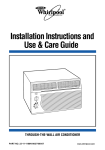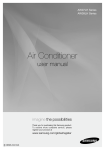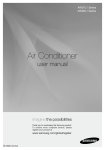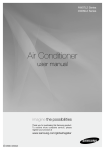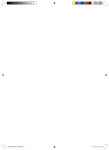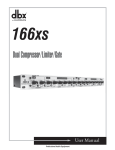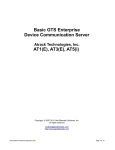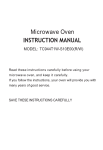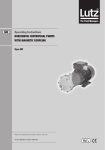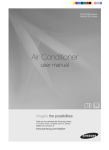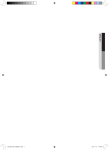Download Samsung AW12L1C User Manual
Transcript
AW12L1 Series Air Conditioner user manual imagine the possibilities Thank you for purchasing this Samsung product. To receive more complete service, please register your product at www.samsung.com/global/register E DB98-31915A(1) DB98-31915A.indd 19 2010-02-03 �� 6:07:10 features of your new air conditioner • Cool Summer Offer On those hot sweltering summer days and long restless nights, there is no better escape from the heat than the cool comforts of home. Your new air conditioner brings an end to exhausting hot summer days and lets you rest. This summer, beat the heat with your own air conditioner. • Easy Maintenance Cleaning and maintenance are no longer a chore. Simply remove the air filter inside the air conditioner, rinse, and dry for clean fresh air. Breathe a sigh of relief at knowing how easy it is to keep the air clean. • A Look for Everywhere The elegant and harmonious design gives priority to the esthetics of your space and complements any of your existing interior decor. With its soft-white color and rounded-edge shape, the new air conditioner adds class to any room. Enjoy what your air conditioner offers both functionally and esthetically. For easy future reference write the model and serial number down. You will find your model number on the bottom side of the air conditioner. Model # Serial # 02_ features DB98-31915A.indd 2 2010-02-03 �� 6:06:52 safety information To prevent electric shock, disconnect the power before servicing, cleaning, and installing the unit. SAFETY INFORMATION Before using your new air conditioner, please read this manual thoroughly to ensure that you know how to safely and efficiently operate the extensive features and functions of your new appliance. Because the following operating instructions cover various models, the characteristics of your air conditioner may differ slightly from those described in this manual. If you have questions, call your nearest contact center or find help and information online at www.samsung.com. What the icons and signs in this user manual mean: WARNING CAUTION CAUTION Risk of death or serious personal injury. Potential risk of personal injury or material damage. To reduce the risk of fire, explosion, electric shock, or personal injury when using your air conditioner, follow these basic safety instructions: Do NOT attempt. Do NOT disassemble. Do NOT touch. Follow directions carefully. Unplug the power plug from the wall socket. Make sure the machine is grounded to prevent electric shock. Call the contact center for help. Recommended instructions or useful information for use. These warning signs are here to prevent injury to you and others. Please follow them carefully. After reading this section, keep it in a safe place for future reference. SEVERE WARNING SIGNS Do not cut the power plug and connect to a different power cable. Never attempt to lengthen the power cable. • Potential risk of fire or electric shock. Do not yank the power cable and touch the power plug with wet hands. • Potential risk of fire or electric shock. Never use a damaged power plug, power cable, or loosened power receptacle. • Potential risk of fire or electric shock. safety information _03 DB98-31915A.indd 3 2010-02-03 �� 6:06:52 safety information Do not place the air conditioner near hazardous substances or equipment that releases free flames to avoid fires, explosions or injuries. • Potential fire hazard or explosion. Do not spray flammable gases such as insecticide near the air conditioner. • Potential electric shock, fire or unit malfunction. Do not block or place items in front of the air conditioner. Do not step, hang onto, or place heavy items on the air conditioner. • Potential risk of personal injury. Do not insert anything such as fingers or branches into the air conditioner vents. • Keep children away from the air conditioner. • Potential personal injury. Consult the place of purchase or a contact center to disassemble or reinstall the air conditioner. • Potential risk of unit malfunction, water leakage, electric shock, or fire. Consult the place of purchase or a contact center to install the air conditioner. • Improper installation carries a risk of unit malfunction, water leakage, electric shock or fire. • If installing in specialty areas, such as a factory complex or saline coastal area, consult the place of purchase or contact center for specific installation details. Install the air conditioner with the support bracket securely fastened to use for an extended period of time. • If the air conditioner falls, it may cause personal injury or loss of property. Ensure the air conditioner is installed in compliance with current national safety standards. Use a rated circuit breaker only. • Never use steel wires or copper wires as a circuit breaker. It may cause fire or unit malfunction. Use an exclusive power source for the air conditioner. • Potential risk of electric shock or fire. Do not put undue stress on the power cable or place heavy objects on it. Do not bend the power cable excessively. • Potential fire or electric shock. If the air conditioner becomes wet, turn off immediately and call your nearest contact center. • Potential fire or electric shock. Disconnect the air conditioner from power supply before it is repaired or disassembled. Use a receptacle that has a ground terminal. The receptacle must be used exclusively for the air conditioner. • Improper electrical grounding may cause electric shock or fire. 04_ safety information DB98-31915A.indd 4 2010-02-03 �� 6:06:52 CAUTION SIGNS Ensure no water gets into the air conditioner. • Potential risk of fire or electric shock. Do not install the air conditioner close to heating appliances to avoid damage. Turn off the air conditioner using the provided remote control or control accessory (if provided). Do not unplug to turn the unit off (unless there is an immediate danger). Cool air should not flow directly towards people, pets, and plants. • It is harmful to your health, pets, and plants. Do not run the air conditioner for an extended period of time in a room with the door closed or with babies, elderly or disabled people. • Open the door or windows to ventilate your room at least once an hour to prevent oxygen shortage. Do not use the air conditioner as a cooling precision instrument for food, pets, plants, cosmetics or machinery. • Potential risk of property loss. Do not drink water from the air conditioner. • Potential health hazard. Do not give excessive shock to the air conditioner. • Potential fire or unit malfunction. Do not expose the dust filter to direct sunlight while drying. • Strong direct sunlight may deform the dust filter. Do not spray water directly on the air conditioner or use benzene, thinner, or alcohol to clean the surface of the unit. • Potential risk of electric shock or fire. • Potential damage to the air conditioner. Do not place containers with liquid or other objects on the unit. The air conditioner is composed of moving parts. Keep children away from the unit to avoid physical injury. Check for damage on delivery. If damaged, do not install the air conditioner and call the place of purchase immediately. Make sure the voltage and frequency of the electric system are compatible with the air conditioner. Insert the dust filter before operating the air conditioner. • If there is no dust filter inside the air conditioner, accumulated dust may shorten the life of the air conditioner and cause electricity waste. Keep indoor temperatures stable and not extremely cold, especially where there are children, elderly or disabled people. Clean the air conditioner after the inner fan stops operating. • Potential risk of injury or electric shock. Clean the dust filter every 2 weeks. Clean the filter more frequently if the air conditioner is operated in dusty areas. Inspect the condition, electric connections, pipes and external case of the air conditioner regularly by a qualified service technician. safety information _05 DB98-31915A.indd 5 2010-02-03 �� 6:06:52 safety information Do not open doors and windows in the room being cooled during operation unless necessary. Do not block the air conditioner vents. • If objects block the air flow, it may cause unit malfunction or poor performance. The packaging material and used batteries of the remote control (optional) must be disposed of in accordance with the national standards. The refrigerant used in the air conditioner must be treated as chemical waste. Dispose the refrigerant following national standards. Have a qualified service technician install the air conditioner and perform a trial operation. Ensure the off-on and protection switches are properly installed. Do not use the air conditioner if damaged. If problems occur, immediately stop operation and disconnect the plug from the power supply. If the air conditioner will not be used for an extended period of time (for example, over several months), unplug the power from the wall. Call the place of purchase or a contact center if repairs are needed. • Potential risk of fire or electirc shock if disassembly or repairs are attempted by a non-qualified service technician. If you smell burning plastic, hear strange sounds, or see smoke coming from the unit, unplug the air conditioner immediately and call a contact center. • Potential risk of fire or electric shock. 06_ safety information DB98-31915A.indd 6 2010-02-03 �� 6:06:52 contents SETTING UP YOUR AIR CONDITIONER BEFORE USE 08 Checking the parts and the control panel 09 Ventilation lever 09 Control Panel OPERATING YOUR AIR CONDITIONER 10 Selecting operation mode 10 Cooling 11 Air Circulation 12 Adjusting the air flow direction 12 Horizontal air flow 12 Vertical air flow CLEANING AND MAINTAINinG YOUR AIR CONDITIONER 13 Cleaning the exterior 13 Cleaning the air filter 13 Maintaining the air conditioner 08 10 13 APPENDIX 14 INSTALLING YOUR AIR CONDITINER 15 14 Troubleshooting 14 Operation ranges 15 Getting ready to install the air conditioner 15 Checking included parts 15 Selecting the best location 16 Setting up the air conditioner 16 Assembly for drainage contents _07 DB98-31915A.indd 7 2010-02-03 �� 6:06:52 setting up your air conditioner before use Congratulations on the purchase of the air conditioner. We hope you enjoy the features of your air conditioner and stay cool with optimal efficiency. Please read the user manual to get started and to make the best use of the air conditioner. CHECKING THE PARTS AND THE CONTROL PANEL Carefully unpack your air conditioner, and check the unit to make sure it is not damaged. Air intake (Inside) Inner air flow blades Vertical air flow blades Air intake (Outside) Air filter (Inside) Ventilation lever Door Control panel Power Cable our air conditioner may slightly differ from illustration shown above depending on your Y model. CAUTION o not attempt to install the power cable yourself. Have a certified installer do the power D cable work for your personal safety. 08_ setting up DB98-31915A.indd 8 2010-02-03 �� 6:06:54 Ventilation lever The ventilation lever is designed to help you get fresh air from outdoors. It can also help prevent strong outdoor odors from entering the room through the air conditioner. The lever is located on the lower right side of the air flow blades. Sliding the ventilation lever to the right lets outdoor air enter the room, and sliding the lever to the left re-circulates existing air within the room. Depending on your model, the ventilation lever appearance and location may slightly differ. Control Panel 1 2 3 Use the Operation knob to set to the desired fan speed. This is helpful in cooling the room. 1 OPERATION KNOB 2 THERMOSTAT KNOB 3 AIR SWING SWITCH Off - Air conditioner stops current operating mode Fan - Air circulation with no cooling Hi Cool - Cooling with high fan speed Low Cool - C ooling with normal fan speed. Set here if there is potential risk of falling asleep with the unit on. Use the Thermostat knob to set the desired temperature. In order to cool the room, turn the knob to the “Cool” position. Cool - M aintains cool temperatures of between 18ºC and 29ºC. Press the Air Swing switch to on to circulate the air from side to side by moving the inner air flow blades. Off - Keeps air flow direction in the desired position On - Provides continuous side to side air circulation You should open the door above the control panel before control. setting up _09 DB98-31915A.indd 9 2010-02-03 �� 6:06:56 operating your air conditioner SELECTING operation MODE Cooling Transform a hot and humid room into a cool haven quickly by closing all unnecessary openings such as fireplace dampers, doors, or windows in the room before running the air conditioner to increase efficiency and save energy. 1. Lightly grasp the Operation knob and turn to the right. The air conditioner is turned on. 2. Place the knob to the desired mode. Hi Cool- Cools room at high fan speed, Med Cool- Cools room at med fan speed. Low Cool- Cools room at low fan speed. Air conditioner starts operating in the selected mode. 3. Lightly grasp the Thermostat knob and turn it clockwise, to the blue position. The further you turn the knob, the lower the temperature. Possible temperature range is 18˚C~29˚C. The air conditioner keeps the temperature constant at the thermostat knob setting. Turn the knob to change the indoor temperature. • If current outside temperatures are much higher than the selected indoor temperature, it may take time to bring the inner temperature to the desired coolness. • Air flow can also be adjusted manually. (see page 12 for instructions.) • Avoid drastically turning down the temperature. Energy is wasted and the room does not cool faster. 10_ operating DB98-31915A.indd 10 2010-02-03 �� 6:06:56 operating your air conditioner SELECTING operation MODE Air circulation If the room is stuffy and stale, operate your air conditioner in Fan mode. The air conditioner will reduce humidity without changing the inner temperature. We recommend using this mode during especially humid but cool springdays. 1. Place the knob to the desired mode. Hi Fan- high fan speed, Low Fan- low fan speed. Air conditioner starts operating in the selected mode. 2. The air conditioner removes humid indoor air and emits fresh outdoor air into the room. 3. Slide the ventilation lever, located on the lower right side of the air flow blades, to the right to ventilate the room with fresh outdoor air. (see page 12 for instructions of ventilation lever.) Air flow can also be adjusted manually. (see page 12 for instructions.) operating _11 DB98-31915A.indd 11 2010-02-03 �� 6:06:58 ADJUSTING THE AIR FLOW DIRECTION Air flow can be directed to your desired position. Horizontal air flow 1. Press the Air Swing switch to On. 2. The inner air flow blades move side to side continuously to circulate the air. 3. To keep the air flow direction in a constant position, press the Air Swing switch to Off when the blades reach the desired position. Vertical air flow 1. Move the vertical air flow blades up or down to the desired direction with your fingers. While the air conditioner cools the room, operate the appliance with the blades pointing upwards. If the unit operates in Cool mode for an extended period of time with the blades pointing downward, moisture may generate from the temperature difference and thus carries the risk of electric shock or unit malfunction. 12_ operating DB98-31915A.indd 12 2010-02-03 �� 6:07:03 cleaning and maintaining your air conditioner Keeping your air conditioner clean improves its performance, wards off unnecessary repairs, and lengthens its life. CLEANING THE EXTERIOR 1. Wipe the surface of the appliance with a slightly wet or dry cloth when needed. CAUTION Do not use Benzene, Thinner or CloroxTM. They may damage the surface of the unit and can create a risk of fire. CLEANING THE AIR FILTER 1. Hold the air filter handle, pull it right and out. • If lift it forward when pull right,the air filter out will be easier. 2. Vacuum the air filter completely. 3. Push the air filter back into place. Air filter • For best conditions, repeat every two weeks. • If the air filter dries in a confined (or humid) area, odors may generate. If this occurs, re-clean and dry in a well-ventilated area. MAINTAINING THE AIR CONDITIONER If the air conditioner will not be used for an extended period of time, dry it thoroughly and disconnect from the wall. There may be internal damage if moisture is left in its components. 1. Before storing the appliance, operate the air conditioner in Fan mode for three to four hours to dry the air conditioner completely. 2. Upon removing from storage, dry the inner components of the air conditioner again by running in Fan mode for three to four hours. This helps remove odors which may have generated from dampness. cleaning and maintaining _13 DB98-31915A.indd 13 2010-02-03 �� 6:07:06 appendix TROUBLESHOOTING Refer to the following chart if the air conditioner operates abnormally. This may save time and unnecessary expenses. PROBLEM SOLUTION The air conditioner does not start operating immediately after it has been restarted. • Because of the protective mechanism, the appliance does not start operating immediately to keep the unit from overloading. The air conditioner will start in 3 minutes. The air conditioner does not work at all. • Check that the power plug is properly connected. Insert the power plug into the wall socket correctly. • Check if the circuit breaker is switched off. • Check if there is a power failure. The temperature does not change. • Check if you selected Fan mode. Turn the Operation knob right or left to select another mode. The cool air does not come out of the air conditioner. • Check if the set temperature is higher than the current temperature. Turn the Thermostat knob clockwise to change the set temperature. • Check if the air filter is block by dirt. Clean the air filter every two weeks. • Check if the air conditioner has just been turned on. If so, wait 3 minutes. Odors permeate in the room during operation. • Check if the appliance is running in a smoky area or if there is a smell entering from outside. Operate the air conditioner in Fan mode or open the windows to air out the room. The air conditioner • A bubbling sound may be heard when the refrigerant is circulating through the compressor. Let the air conditioner operate in a selected mode. makes a bubbling sound. The air conditioner vibrates excessively or makes a lot of noise during operation. • Check if there is a gap between the air conditioner and the wall. Insulate the crack securely. Water is dripping from the air flow blades. • Check if the air conditioner has been cooling for an extended period of time with the air flow blades pointed downwards. Condensation may generate due to the difference in temerpature. Push the vertical air flow blade upward and run the appliance. OPERATION RANGES The table below indicates the temperature and humidity ranges the air conditioner can be operated within. Refer to the table for efficient use. MODE COOLING OPERATIONAL TEMPERATURE INDOOR OUTDOOR Approximately 21˚C~32˚C Approximately 21˚C~43˚C INDOOR HUMIDITY - 14_appendix DB98-31915A.indd 14 2010-02-03 �� 6:07:06 installing your air conditioner GETTING READY TO INSTALL THE AIR CONDITIONER First select a room and check conditions prior to installation. Checking included parts Check that all necessary parts are included. Actual accessories may slightly differ from the illustration shown below. Gasket Drain tube Rubber cap Screws Selecting the best location The unit should be level when installed, so that the drainage system and other mechanisms operate efficiently. If possible, install the unit in a shaded area on the home’s north or east side. Before installation, select a location that fulfills these requirements: • easy access to control panel. • away from direct exposure to sunlight. • adequate ventilation. • can easily connect to a power source. • can support the weight of the air conditioner and will not cause increased operating noise and vibration. • where there is no obstacles near the air inlet and outlet. • the bottom of the unit clears at least 750mm above ground level. indoor side awning outdoor side 75mm min. 300mm 170mm 500mm 500mm 500mm about 3˚ 750mm <Fence, wall or other obstacles> 150mm min. Outdoor side 45˚ Indoor side 100mm or more 45˚ If the wall is thicker than 150mm, cut the back of the wall at 45°. installing _15 DB98-31915A.indd 15 2010-02-03 �� 6:07:08 installing your air conditioner SETTING UP THE AIR CONDITINER The air conditioner must be installed horizontally or tilted slightly to the outside for proper water drainage. Assembly for drainage Once a location has been selected for installation, proper drainage should be established. If the drain tube and/or drain hose are not provided, call your nearest contact center. 1. Attach the gasket with screws 4 1 and the drain tube 2 to the base pan hole 3 in the rear side of the unit 4 1 REAR SIDE 3 2 2. Connect the Rubber Cap 5 to the drain tube hole. 5 On exceptionally hot and humid days the air conditioner may overflow condensed water. In hot and high humidity zones, make sure the Rubber Cap have been removed . 16_ installing DB98-31915A.indd 16 2010-02-03 �� 6:07:09 memo _17 DB98-31915A.indd 17 2010-02-03 �� 6:07:09 UI'MPPS)BOKJO#VJMEJOH6OJWFSTJUZ1BSLXBZ/PSUI#POJGBDJP (MPCBM$JUZ5BHVJH.FUSP.BOJMB1IJMJQQJOFT 4".46/( 4".46/( 4".46/( XXXTBNTVOHDPN DB98-31915A.indd 18 2010-02-03 �� 6:07:09


















